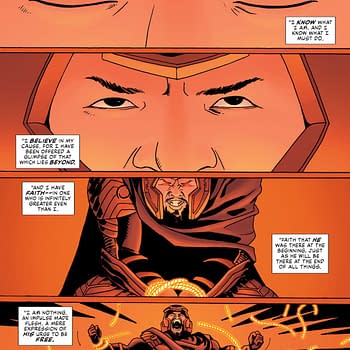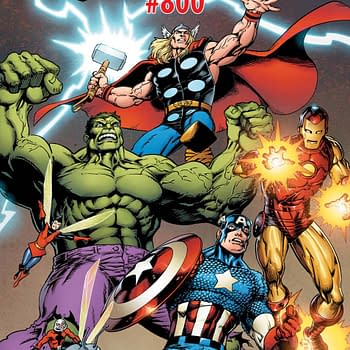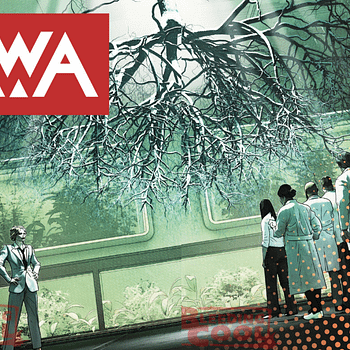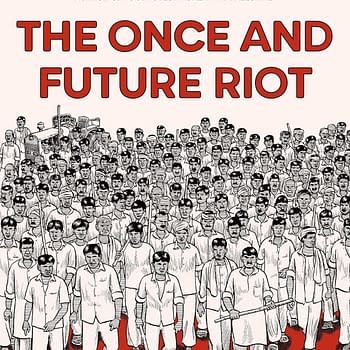Posted in: Comics, Recent Updates | Tagged: boom studios, Comics, entertainment, Giant Days, John Allison, Lissa Treiman
Giant Days Gets Giant Sized: Talking With John Allison And Lissa Treiman, Plus Giant Preview
By Jason Karlson
Fans of Boom Studios' Giant Days got a surprise treat this month when it was announced that the series would be expanded from six issues to twelve, doubling both the series length and the time readers get to spend with the unlikely trio of Susan, Esther and Daisy in their first year talking the obstacle course that is university life.
Although John Allison had previously commented about writing the series as six issues, a regular British sitcom series length, it feels as if the series now has a little bit more breathing space. With issue four only just starting to explicate upon the complex personal history between Susan and Mcgraw as well as Daisy tentatively questioning her own sexuality, the extra six issues will hopefully give more time to dive into these stories.
The team behind Giant Days is long time webcomic artist John Allison and Disney storyboard artists Lissa Treiman who together bring us the exploits of the girls' Giant Days. Issue five of the now expanded series hits shelves on July 15th and both creators managed to take time out between issues to talk to Bleeding Cool about the series so far.

John Allison: It's the opposite of a strange experience, it's a delight. I love drawing but ultimately it's the bottleneck on my creativity. I can manage one page a day. Maybe two, but at the end of the day my eyes won't focus. I'm always fighting a certain stiffness in my art that comes out of starting in comic strips and a lack of training, but there's no stiffness in Lissa's art, she can draw anything. She puts so many fun details in the panels that I didn't come up with. Having her as the artist on the series is like winning a prize.
Lissa Treiman: It was the twin factors of being able to collaborate with John whose work I'd been a fan of since forever and being able to work on a published comic. I've always wanted to break into the comic book scene professionally, so when I saw the opportunity I hurled myself at it! There was a brief adjustment period drawing the characters; keeping them in my own style, but still always wondering "… am I drawing them right?" I've got all three of John's original Giant Days stories in print, and those have been within arms-length of my desk for reference as I've been drawing the series. But I like to think my style has been pretty simpatico with his sensibilities, so for the most part it hasn't been that strange at all
JK: What is it about these three particular characters that drew you back to them for another series? Was it strange writing slightly tweaked versions of them for this book?
JA: The original Giant Days series was a really pleasant surprise to me. There was only ever meant to be one issue, as a kind of pilot to pitch with. I never intended to draw it full time. I pitched it to Oni with my friend Jonathan Edwards drawing it (he most recently worked on 21st Century Tank Girl, but it was far from a polished offering at that point and probably too soon. Something nagged at me for the next two years though, and eventually I did the two further stories back to back on my website. I knew there was more in the tank if I wanted to do more so I started looking for the right place to pitch it.
JK: What attracted you to Boom in particular?
JA: I'd worked with Shannon Watters doing covers for Marceline & The Scream Queens, so when Boom opened up new pitches for Boom!Box, I sent them a pitch document which, for the first time in my life, actually looked like a pitch.
JK: Lissa, did you follow John's work before you got together on this Giant Days series and which is your favourite character to draw?
LT: I've been reading John's comics for YEARS! I think I started reading Scary Go Round around the end of high school or the beginning of college, and I've followed it through to Bad Machinery. So yeah, I'm definitely a fan. Can't wait to see what he's got planned for the future!
Daisy! She's got long noodley arms, and I've gotten some of my favourite expressions out of her. She's "the innocent" one, which means her emotions are just… out there, and that lends itself to some broader acting that i can have fun with. Plus that hair. She might actually be my favourite character across the board, don't tell the others.

JA: It's hard! Having drawn everything I've written, by now I write completely visually. I often rough out the whole page as I write, doing the whole thing in pencil on lined pads. Typing out the scripts and just describing the action was completely new for me. I'm just not used to doing it, it was almost embarrassingly personal, having to describe what the characters were thinking. That probably sounds ludicrous.
JK: Lissa, How does your approach to working on comics differ from working on storyboards? What is the most obvious thing you bring from that side of things?
LT: I've always thought of storyboards and comics as similar-but-different cousins. Both are visual story-telling media, so an understanding of how composition choices and acting can affect the clarity and tone of a story is definitely a crossover skill-set. The biggest difference is in the format of the media, I guess.
For storyboards you're composing frames in one uniform aspect ratio, and you generally have as many panels as you need to convey an idea, although, as in most things, less is more. In comics that aspect ratio gets totally blown up, and suddenly it's not just best composition for a panel, its size and shape of that panel, composition of panels on the page… just a lot more to think about. You also generally have fewer panels to convey ideas with, so you've really got to be economical with how you use the space you have. It's been a fun challenge, I've definitely learned a lot.
JK: Lissa, do you prefer working in comics or animation and storyboarding?
LT: Between comics and animation, I can't say! They scratch different itches I think. Both have been collaborative processes for me, which I like. I like the instant gratification that comes with comics; it can be years before a film I've worked on hits theatres, but these comics seem to be on the shelves before I've even finished them!
Not to mention people actually get to see the work I do in comics, storyboarding is so behind the scenes, there's so much artwork that no one ever sees. But I like being a part of the film making process too. It's different! I feel like we're thinking about things a little more dynamically because that's what the medium does. And thinking how it's all going to move, and sound, and all the added dimension of that. I'm one of many cogs in that machine it but it's a cool thing to help make. I guess yeah, they both fulfil different things for me as a storyteller.

JA: The print comic is almost exactly the same number of pages as I write for the webcomic in a month, but I was very conscious of wanting each issue to be mostly self-contained. Character threads exist from issue to issue but I need to resolve a central point every month. I have a love-hate relationship with comic book continuity. My life's work is to make it invisible to new readers.
JK: Issue 3 in particular features elements of sexism and lad culture that's very much in the public eye at the moment, do you think it's important to deal with these issues and still have a comic be entertaining? How do you approach subjects like this when writing?
JA: We live in such polarised times, it's pretty shocking to me. I came of age in the mid-nineties, less enlightened times in a lot of ways but there was a sense of consensus and compromise if you worked at it. Now, the voice of the left is shrill, the voice of the right is pompous and entitled, and if you seek any kind of consensus, you're a traitor. If I approach any issue that I can't just joke away, I try to do it in a way that gives everyone the fairest shake I can hand out. I try not to be didactic, because God knows I change my mind about things every day.
And here's a preview of the coming issue, #5, for us folks here at Bleeding Cool:
We know only two things for certain of Jason Karlson; that he was born on the wagon of a traveling show to Latverian parents, and that tales of his origins are wholly fictional. His writing style is pithy and insightful, with hints of oak and red berry, finished with earthy tones and somber notes. If he were to describe himself in a single word it would likely be self-deprecating. He occasionally tweets over at @marfedfolf and rambles on at marfedblog.wordpress.com.






















